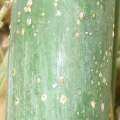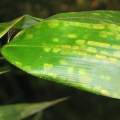|
Pests of bamboo plants are generally not a problem for Australian bamboo growers. In fact, most bamboo here in Australia is not significantly affected by insect pests at all. As you examine bamboo plants with a magnifying glass you see small insects and the tiny marks they have left. You also find spiders, and predatory insects such as ladybirds, lacewings, and assassin bugs. They must of course, feed on something. It's not surprising that frogs and birds like bamboo so much.
Yet, some bamboo species can become heavily infested with either Bamboo Mealy Bugs or Bamboo Mites; two pests of bamboo that have been imported into Australia along with bamboo plants. These two pests are mainly a problem with ornamental bamboo plantings, and will have minor impact on bamboo grown for timber and shoot production. What makes these two 'nasties' so bad is the high level of maintenance required to manage them and their notorious resistance to pesticides. And, their ability to populate their hosts explosively under favourable conditions. The control methods are well known to professional horticulturists who need to manage these pests, and are well documented. IPM (Integrated Pest Management) is the art (and science) of managing pests that you cannot eliminate.
Noxious Bamboo Mealybugs (Antonina pretiosa). There may be more than thirty mealybugs that inhabit bamboo world-wide, but this is the only one that is a problem on ornamental bamboo species in Australia. In tropical areas they are said to be able to live on almost any bamboo, and though they may not thrive or be easily noticed they can survive and breed and move from there to other bamboo plants. They not only weaken the host plants by feeding on their sap, but they produce sugary 'honeydew' which grows sooty-mould and attracts ants, which spread the honeydew on their feet. Ants also spread the pests around and protect them from natural predators. In temperate areas many bamboos appear to be totally unaffected. Male mealy bugs are tiny flying insects but females cannot fly. They spread by crawling to new feeding sites, and as 'crawlers' are very mobile. Unfortunately many smaller Bambusa species including very useful ones like the hedging (B. multiplex) bamboos can be badly affected especially when they are growing lush, soft new growth. You can successfully eradicated bamboo mealy bugs from small potted plants, by removing all infected material, treating the new growth and keeping them clean for a couple of years. Larger plants in the ground are more difficult to treat. We treat all new plants we buy in, to prevent bringing in pests with them, and we limit the numbers of susceptible species we grow.
Bamboo spider mites (Schizotetranychus celarius) mainly live on running bamboos (especially Phyllostachys, Pleioblastus and Sassa species). They are not too distant relatives of the well known Two Spotted Mite, commonly known as 'Red Spider' and thrive in the same dry dusty conditions. They are also very difficult to control on the most susceptible species, though some others are only slightly affected. They cause unsightly damage to the leaves and weaken the bamboo plant by sapping it's strength and lowering it's ability to photosynthesise. They spin tough silken webs under which they, their eggs and offspring are protected, and, they may well share the ability of other spider mites and spiderlings to 'drift' on the wind. (Some spiderlings can 'hang-glide' on sheets of gossamer and travel for miles). 'Crawlers' move easily through foliage, and on some bamboos most leaves can be badly affected.
Mealy bugs and spider mites are amongst the worst pests in horticulture, and there are a large number of both that infest a wide variety of plants world wide. Orchards, plantations and nurseries are perfect breeding grounds for these and other pests.
Home gardeners who continue to grow these pest-infected bamboos have two main control options. Firstly, to cut out infected wood regularly and wait for bamboo's incredible resilience to produce more (some Bambusa species, for example, are rarely found with clean two or three year old wood). Or, to spray the bamboo. Those who have the skills and timing to work with non-toxic sprays (such as horticultural soap or oil sprays) might also use predators (Biological Control Agents), or other environmental controls along with careful monitoring to manage a pest they may never eliminate. Those who have waited till the problem is very obvious, might need to use to use much more toxic sprays (as well as removing all infected growth) to have any affect at all.
Unfortunately many bamboo species that by virtue of their size or growth habit would otherwise be excellent landscape plants, are spoilt badly as ornamental plants by the presence of these disfiguring sap-feeders. And failure to fully appreciate these bamboo pests may even lead some to think they have them permanently 'under control'.
It's also important to note that there are varieties that seem to be so resistant to these pests, that they are not a problem at all. We have made this a major factor in deciding which species of bamboo plants we should grow, and in what numbers we should produce them.
In northern Australia there is a leaf-rolling caterpillar that causes significant damage to bamboo plants. This pest rolls up the young leaves while they are still growing and eats them from the inside, protected from predators within its silken nests. It doesn't seem to survive on bamboo through our cool winters here in Kempsey, Australia though I once kept one in a jar till it became a moth similar in appearance to Light Brown Apple Moth (a well known Leaf Roller and pest of many plants).
You find hard scales on some bamboos. Hard scales do not produce sugary excretions (honeydew) like soft scales, aphids and the dreaded mealy bugs, and so do not rate as significant pests of bamboo plants. These small sapsuckers leave marks (over time) on the culms and branches. Some species are more affected than others, but they rarely spoil the appearance or lessen the vigour of bamboo plants. In old congested clumps of some bamboo species you might see large numbers. Soap and/or vegetable oil sprays specially formulated for horticultural use give good safe control on small bamboo plants, if needed, and do not interfere with natural predators.
It's tempting to add wallabies and kangaroos to the list of bamboo pests. These magnificent animals are incredible survivors and clever opportunists, and can be extremely destructive to many of our useful plants, including small bamboo plants, which they can severely damage. A piece of wire netting and a couple of pickets makes a good reusable guard, if it's not practical to fence the whole area. In our region they are hungriest when the runners are shooting and they will not only strip leaves from, but also chew and break the shoots on small bamboo plants. Larger clumping bamboo is generally safe from browsing and grazing animals.
Top Home Contact Us
Bamboo Selection Cultivation Propagation FAQ
Black Bamboo More Photos Bare Rooted Landscapers

|





